Keeping Our Kids Safe
The recent New Zealand documentary, “Are you ready”, brought some sobering reality to the potential effects a Natural disaster could have on our nation. The question was not “if” we have a disaster but more realistically “when” we have one.
In 1998 the New Zealand Ministry of Education undertook a Nationwide structural survey of all school buildings. The directive from the Ministry was for education boards to plan to rectify any building defects, which failed to meet their requirements, in each schools 10 year property plan.
Two schools featured here have taken the steps required. In both cases the cost effective way to meet the Ministry criteria was to replace the existing heavy tiled roofs with lightweight roofing.
Looking beyond our schools at the effect of natural phenomenon on our homes, should we ask if there is a lesson to learned?
Extracts from the Ministry of education directive.
3.2 Heavy Roofs
Issue
As long as they are adequately connected to their foundations and do not contain a heavy roof or ceiling, school buildings are expected to perform adequately during a severe earthquake almost irrespective of configuration. The major reason for this is the lack of seismic mass at roof level generating significant lateral forces. This is not the case if the building has a heavy tile roof. All buildings with heavy tile roofs have been identified.
Recommended Action
All heavy tiled roofs are required to be removed and replaced with a lightweight roof. The only exception to this is if the school wants to retain the tile roof and this would need to be agreed to by the District Property Manager. In the latter circumstances, a detailed analysis of the building would be required and strengthening provided, as necessary, to meet the full requirements of NZS 1170.5 including the 1.3 return period factor.
The costs that were allowed in the 1998 National Survey were for replacement of the heavy tiles with corrugated iron. This also included some allowance for replacement of damaged roof framing members and bracing should this have occurred. At the time that the heavy tile roof is removed, the connectivity between the top of the walls and the roof and ceiling members should be checked by a structural engineer to ensure that the load transfer between the ceiling or roof diaphragm and the walls can take place. While on site, the engineer should also visually check the roof bracing and the condition of the roof framing.
National Structural Survey
Because many school buildings were built before modern structural design standards, the Ministry commissioned a nation wide structural survey of all school buildings in 1998. The purpose of the survey was to identify specific structural defects that could potentially cause death or serious injury during wind or earthquake or every day loadings. As well as buildings, site structures such as retaining walls were also checked.
For the full report visit the Ministry website: http://www.minedu.govt.nz/index.cfm?layout=document&documentid=8544&inde...
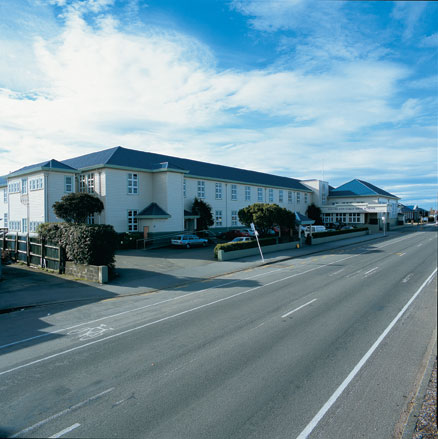 Southland Girls High
Southland Girls High
“The Tweedsmuir Junior High next door was closed at the end of last year and Southland Girls was expanded to take in years seven and eight,” says Yvonne Brownie, Principal of Southland Girls.
The decision was made to have Southland Girls combine the now empty buildings and the school.
Architect John McCulloch says, “Southland Girls High School in Invercargill needed to be structurally upgraded. The refurbishment included the installation of a new roof. The existing concrete tile roof was deemed to be too heavy, under the Ministry of Education building requirements, and a lightweight roofing was specified. Installing a new roof also provided an opportunity for the school to promote a new identity, particularly as it was extending and taking over the neighbouring intermediate
school premises. Gerard Tuffcoat satin tiles were chosen for their light weight, their cost effectiveness and character, which is in keeping with the look of the former concrete tile roof. We opted to change the colour of the roof by choosing Wedgwood Blue tiles. The colour is sufficiently different to create an awareness of the new identity. It also enhances the sense of a large campus.”
Trevor Keeste from Permacoat Roofing Invercargill, won the roofing tender for the project which started in early January, for safety reasons, to ensure the bulk of the work would be completed before the beginning of the school term.
“The most challenging part of the work was removing 350 tonnes of old concrete tiles which were breaking as they were removed. The new roof weighs in at just 35 tonnes which is a huge weight saving of 315 over the 7000 square metre roof,” says Trevor.
”The primary reason for making a change to this roof is safety.” says Grant Williams, business development manager for AHI Roofing Ltd. “The Ministry of Education require that some schools with heavyweight roofs be either structurally strengthened or the heavy weight tiles be replaced with a lightweight alternative to meet earthquake regulations.”
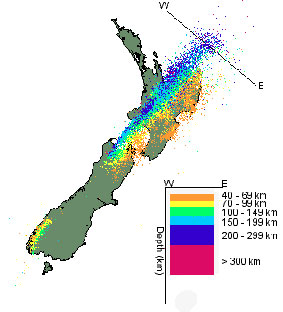 Earthquakes
Earthquakes
New Zealand lies on the boundary between the Pacific and Australian tectonic plates which basically follow the country’s mountainous areas, diagonally from east to west. The eastern areas of this divide generally experience shallower earthquakes than the western areas as indicated in figure 1. The Institute of Geological & Nuclear Sciences locates about 14000 earthquakes in New Zealand each year however most are too small to be felt. It is estimated that between 100 and 200 earthquakes are significant enough to be felt.
Most earthquakes which cause damage are of a magnitude of 6+ and we generally experience one of these per year. A magnitude of 7 occurs about every 10 years and a magnitude of 8 about once a century. The largest known earthquake in New Zealand was the Wairarapa earthquake in 1855 which was an estimated magnitude of 8.2. The biggest New Zealand earthquake since instrumental recording began was the 1931 magnitude 7.8 Hawke’s Bay earthquake with a death toll of 256.
When seismologists averaging suggests there is an earthquake of a magnitude of 6+ every year it really means that within one hundred years there is likely to be one hundred earthquakes recorded.They do not occur evenly through time and may happen in clusters.
Some historical New Zealand earthquakes
- Earthquake Year Mag.
- Wairarapa 1855 8-8.2
- Hope Fault 1888 7-7.3
- Buller 1929 7.8
- Napier 1931 7.8
- Inangahua 1968 7.1
- Edgecumbe 1987 6.1
- Weber 1990 6.1
- Arthur's Pass 1994 6.7
New Zealand is fortunate that whilst experiencing earthquakes in a similar Richter scale range to other countries we have not suffered similar loss of life. 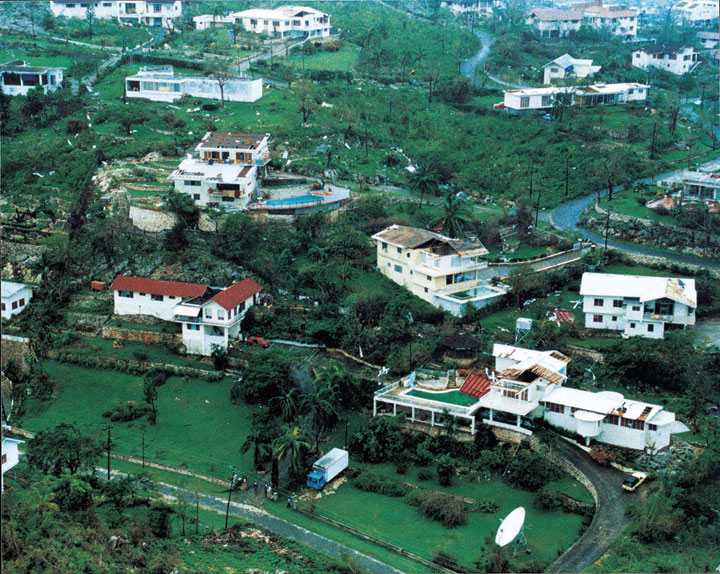 Much of this comes down to three factors. The standards of our buildings and building code, the density of our population and for want of a better expression, “luck”. Most agree it is not an area for complacency as we continue to hear it is not “if” it happens but “when”.
Much of this comes down to three factors. The standards of our buildings and building code, the density of our population and for want of a better expression, “luck”. Most agree it is not an area for complacency as we continue to hear it is not “if” it happens but “when”.
Wind and rain
The "wind uplift" performance of roofing products is becoming an increasingly important factor in New Zealand as more and more people build on sites that take full advantage of our undulating topography and coastal environment.
All Gerard roofs feature interlocking tiles secured in place with a unique horizontal fastening system. The result is a very strong roof with superior wind resistance, which allows specification in very high wind zones.
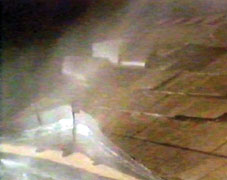
It has taken the force of tornadoes and cyclones to demonstrate the significant benefits offered by Gerard Roofs horizontal fastening system. High winds blowing over a roof cause a difference in air pressure between the inside and outside of the roof. The stronger the wind, the higher the pressure differential. This results in "wind uplift" perpendicular to the roof. This "wind uplift" is the primary cause of failure in roofs with vertical fastenings, where the fastener can be simply pulled out. Both Concrete tiles and Asphalt shingles are fitted with vertical fastenings. With the horizontal fastening method used with Gerard Roofs the fasteners must shear off for the roof to fail, a less likely proposition, especially considering there are eight fasteners holding down each tile.
Testing was carried out in Florida, an area which has strict regulations because of regular hurricanes. The roof panels were fixed, ie horizontally fastened to wooden battens which were fastened to the plywood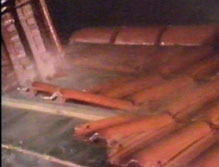 “underdeck”. The air stream was provided by the propeller of a 1500kw aircraft engine wind generator. Water spray was added to the airstream upwind of the eave at a rate equal to 200mm of rain per hour. The roofing panels and the “underdeck” were checked for any uplift or leakage. The wind speeds were steadily increased to 160m/h with no leakage occurring on the Gerard roof, even after prolonged exposure. The roof remained firm and no uplift was observed.
“underdeck”. The air stream was provided by the propeller of a 1500kw aircraft engine wind generator. Water spray was added to the airstream upwind of the eave at a rate equal to 200mm of rain per hour. The roofing panels and the “underdeck” were checked for any uplift or leakage. The wind speeds were steadily increased to 160m/h with no leakage occurring on the Gerard roof, even after prolonged exposure. The roof remained firm and no uplift was observed.
